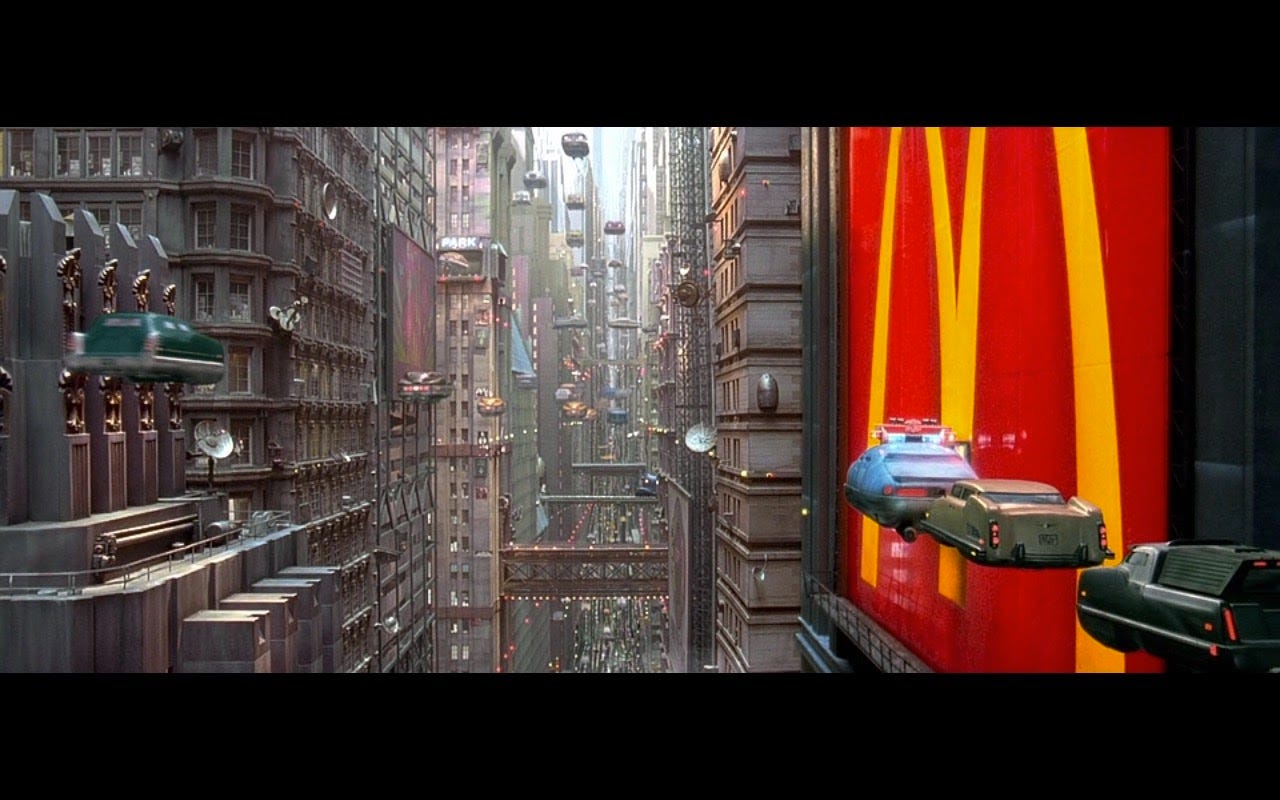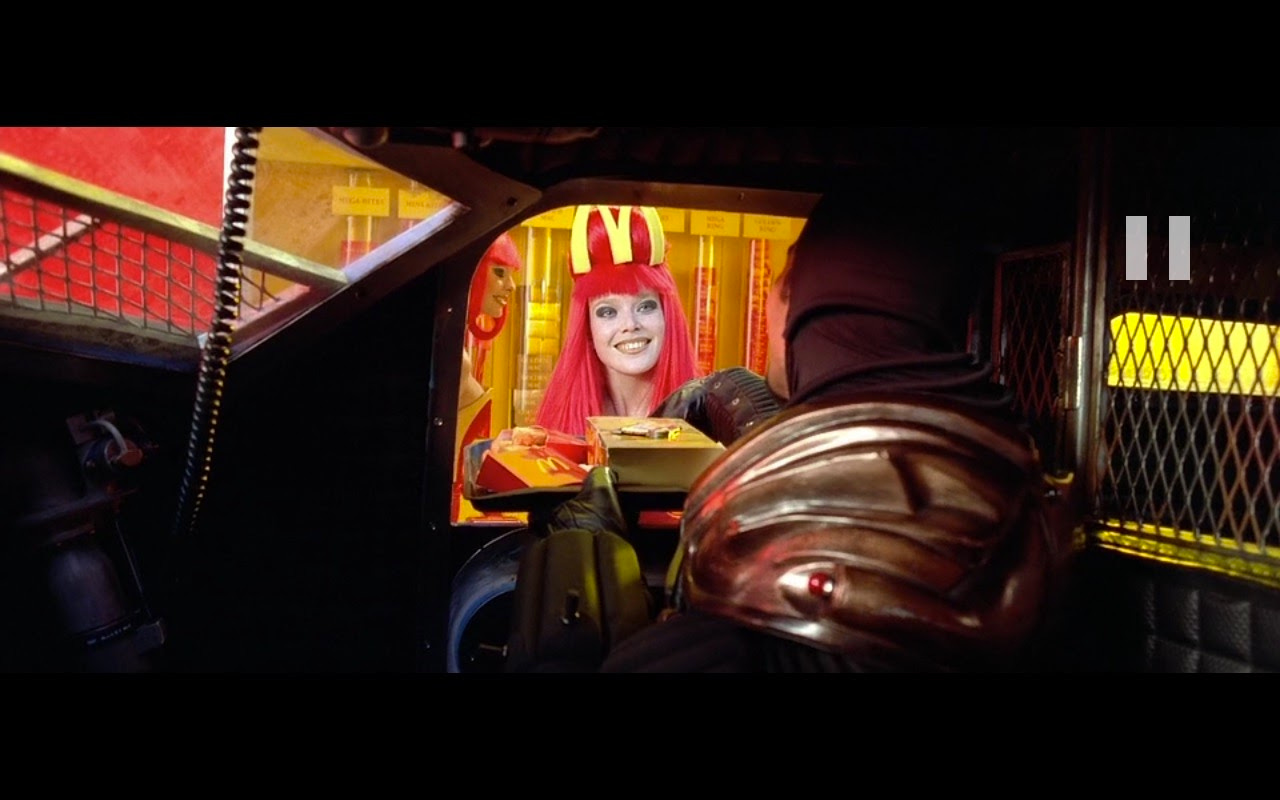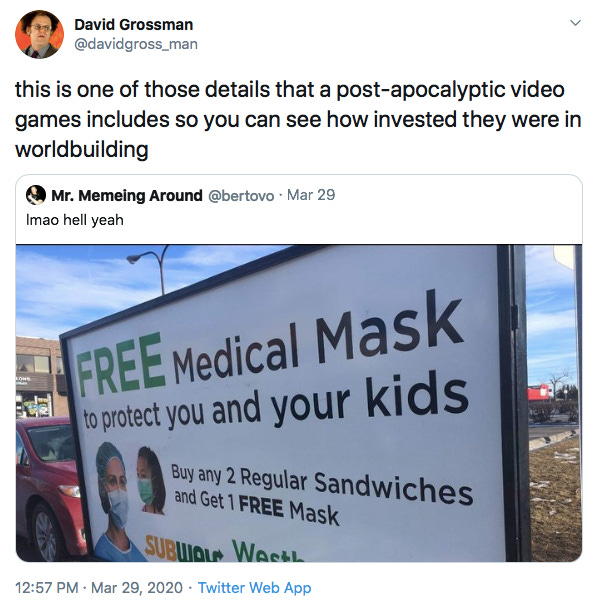Why is this interesting? - The Real Brands in Fictional Worlds Edition
On sci-fi, brands, and world building
Adam Wray (AW) first came on our radar when he was editing the FashionRedef newsletter (RIP) which was a wonderful digest of must-read fashion and culture stories. He’s currently writing for WITI fav the Financial Times, and also serves as a consultant to fashion brands and retailers. I have fond memories of hanging out with him in Montreal back when an American could cross the Canadian border. -Colin (CJN)
Adam here. I grew up a nerdy kid who spent as much time in fictional worlds as I did in the real one. From Star Wars to the novels of William Gibson, from immersive video games like the point-and-click adventure Myst and the Final Fantasy series, I was drawn to settings that felt spacious and textured, that were rich with detail—that had, in fact, their own interior cultures.
Naturally, I loved The Fifth Element, Luc Besson’s 1997 space opera. The moment I was introduced to Bruce Willis’ Corbyn Dallas and the scuzzy, towering futurity of his New York City, messily latticed with flying traffic, a switch flipped and I was all the way in.
There’s no shortage of indelible images in the film, but the one that I return to most often is two cops in a hovering squad car, ordering drive-thru from a mile-high McDonald’s.

It’s certainly not the only instance of a giant IRL brand appearing in a popular work of sci-fi—see also: Nike in Back to the Future; Reebok and Seiko in the Alien series; Atari in Blade Runner—but it’s my favorite. Where else are you gonna see a McDonald’s uniform designed by Jean-Paul Gaultier?

Why is this interesting?
The commercial function of these branded instances is obvious. The Fifth Element, Back to the Future, Aliens—these are all blockbusters that have reached, by now, hundreds of millions of viewers worldwide. One needn’t squint too hard to see the value of placing products within these worlds. (They’re even useful as bits of design fiction: Back to the Future debuted the self-lacing Nike Air Mag, which now actually exists and continues to provide inspiration for other self-lacing models, like the Hyperadapt.)
What’s most interesting to me is the narrative function that these corporate incursions serve. While most product placements are incidental to the stories that support them, The Fifth Element’s McDonald’s actually has a job to do. The conspicuous appearance of a real-life brand in an unfamiliar fictional world is a shortcut to a sense of naturalism. It ruptures and repairs the story world almost simultaneously. It has the initial effect of snapping the viewer out of the story—"Hey! McDonald’s! I eat there!”—then almost immediately pulling them back in more deeply than before—”Can’t be that different a world from mine, it’s got a McDonald’s!” It tells the viewer that they’re still on Earth while avoiding any stilted exposition.
Brands—their logos, to be precise—have this effect because they belong exclusively to our shared culture. A brand is not a product, not a tool, not a tangible object of any kind. We could imagine any number of societies inventing the automobile, but only ours would have produced, say, the Ford F-150 and all of the value and identity associations attached to it. There are endless possible potable neon liquids, but only one Gatorade—the name and its attendant iconography mean something. Branding is one of the most complex pieces of the puzzle that makes us, us.
I think this is why some of us love visiting McDonald’s when abroad to sample the regionally-specific items. (We’ve all seen Pulp Fiction, I assume.) Novelty aside, these localized menus offer surface-surface level expressions of their respective culture’s values, articulated within parameters that make them immediately legible to Westerners. Why can you get a veggie burger at a Mumbai McDonald’s but not in St. Louis, right? We love to talk about ourselves—this is us prompting another culture to tell us about itself using our language.
This exchange is only possible because of the utter ubiquity of these types of chains. There is no doubt a neocolonial dimension to the global spread of American-originating fast-food restaurants, but most customers aren’t applying that sort of critical lens while considering whether they’ll supersize their meal deal. People do genuinely love this shit. We love convenience, we love value, we love a juiced-up, supernatural umami bomb of a meal. On a planet spinning to an ever-quickening rhythm, these are preferences that verge on universal, and they gird a mode of consumption that has defined the past half-century and laid the groundwork for the next. If it’s well understood that sci-fi authors imagine futures to process their present, then it’s natural that they’d invoke megacorps to tie their worlds to ours. As the late pop music critic Ellen Willis put it in an essay about Blonde on Blonde-era Bob Dylan: “The pop artist looks at mass culture naively and sees beauty in its regular patterns; like an anthropologist exhibiting Indian basket-weaving, Warhol shows us our folk art—soup cans.” These mass branded totems may well be our cave paintings. They are woven inextricably into the contemporary experience, and so the way they function—both materially and symbolically—needs to be reckoned with. The brands we build and sustain reflect our society’s dominant values. If our world ends up looking like Demolition Man, where Taco Bell is the only restaurant remaining, we shouldn’t be too terribly surprised. (AW)
Tweet of the Day:
As always, there is a tweet that crams everything I’ve tried to convey here into one pithy image-caption combo. Basically, what I am trying to say is:

Quick Links:
The first thing I thought of reading today’s WITI was this bit from the New Yorker about 2001’s brand choices: “By rendering a not-too-distant future, Kubrick set himself up for a test: thirty-three years later, his audiences would still be around to grade his predictions. Part of his genius was that he understood how to rig the results. Many elements from his set designs were contributions from major brands—Whirlpool, Macy’s, DuPont, Parker Pens, Nikon—which quickly cashed in on their big-screen exposure. If 2001 the year looked like ‘2001’ the movie, it was partly because the film’s imaginary design trends were made real.” (NRB)
The non-alc space continues to gather steam with the launch of Ghia. (CJN)
GQ profile of Killer Mike (CJN)
Thanks for reading,
Noah (NRB) & Colin (CJN) & Adam (AW)
—
Why is this interesting? is a daily email from Noah Brier &Colin Nagy (and friends!) about interesting things. If you’ve enjoyed this edition, please consider forwarding it to a friend. If you’re reading it for the first time, consider subscribing (it’s free!).


